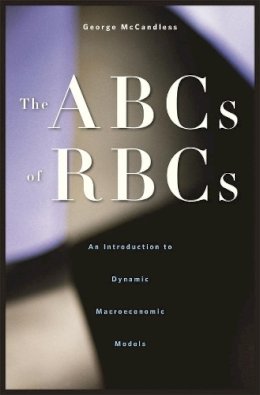
The ABCs of RBCs: An Introduction to Dynamic Macroeconomic Models
George McCandless
The ABCs of RBCs is the first book to provide a basic introduction to Real Business Cycle (RBC) and New-Keynesian models. These models argue that random shocks—new inventions, droughts, and wars, in the case of pure RBC models, and monetary and fiscal policy and international investor risk aversion, in more open interpretations—can trigger booms and recessions and can account for much of observed output volatility.
George McCandless works through a sequence of these Real Business Cycle and New-Keynesian dynamic stochastic general equilibrium models in fine detail, showing how to solve them, and how to add important extensions to the basic model, such as money, price and wage rigidities, financial markets, and an open economy. The impulse response functions of each new model show how the added feature changes the dynamics.
The ABCs of RBCs is designed to teach the economic practitioner or student how to build simple RBC models. Matlab code for solving many of the models is provided, and careful readers should be able to construct, solve, and use their own models.
In the tradition of the “freshwater” economic schools of Chicago and Minnesota, McCandless enhances the methods and sophistication of current macroeconomic modeling.
Product Details
About George McCandless
Reviews for The ABCs of RBCs: An Introduction to Dynamic Macroeconomic Models
Martin Uribe, Duke University The ABCs of RBCs is a focused text that does exactly what it sets out to do, which is to explain the current techniques for the analysis of real business cycle models. A highly useful primer.
Kim Border, California Institute of Technology For every economist who ever felt stymied by the process of numerically approximating equilibria of [RBC] models, and for all current and future graduate students who are or who will be aiming to learn this technology, this book is a truly wonderful treatment
a user's guide
to moving from the set of first-order conditions and budget and resource constraints that characterize the solutions to these models to putting these models on a computer and making them operational...This is a textbook in the truest sense
every word, diagram, and table have been assembled to make learning this technology as transparent as possible. For the most part, the exposition is truly outstanding. As you read the text, you feel as if they were detailed notes written by someone in the process of learning and distilling a lot of information about a difficult and nuanced topic. And this is exactly how it was done, as noted by McCandless in the text...While there is some overlap with other treatments in the literature, there are aspects of the book that are done better here than elsewhere...The book excels exactly where many texts do not by being remarkably transparent and explicit. If you occasionally feel that advanced economics textbooks are a bit like those impossible "how-to-assemble furniture instructions" we have all sweated over, this book is for you...This book would be a terrific fit in a first year graduate course in macroeconomics...or used in a second year course that focuses on quantitative analysis of macroeconomic models.
Lee E. Ohanian
Journal of Economic Literature
